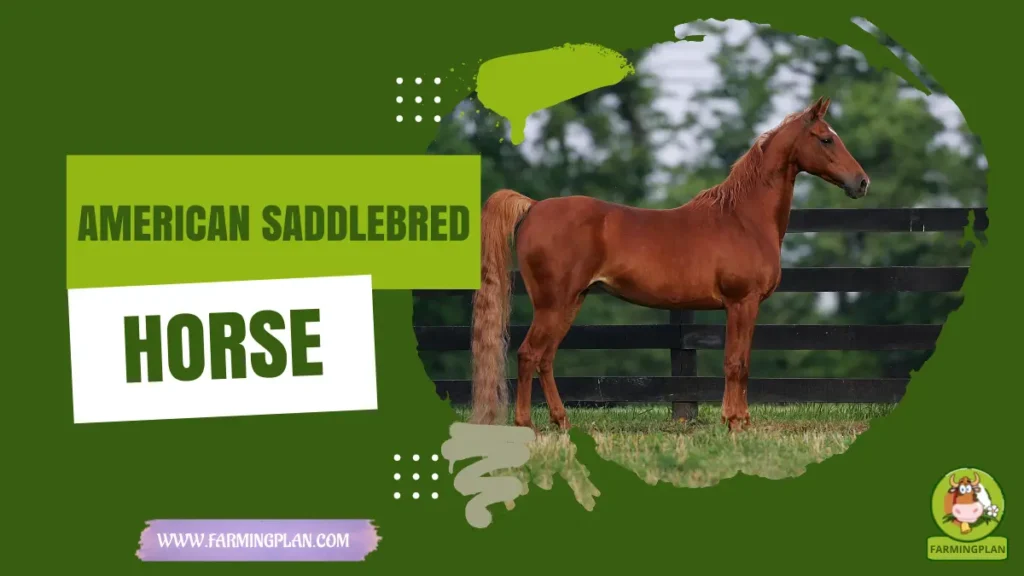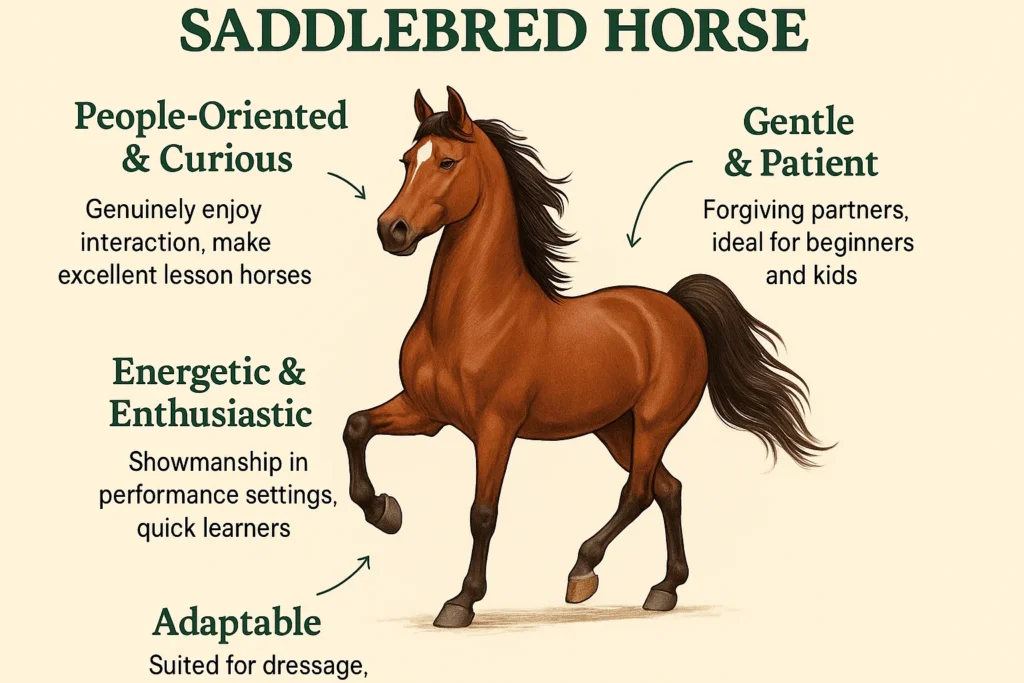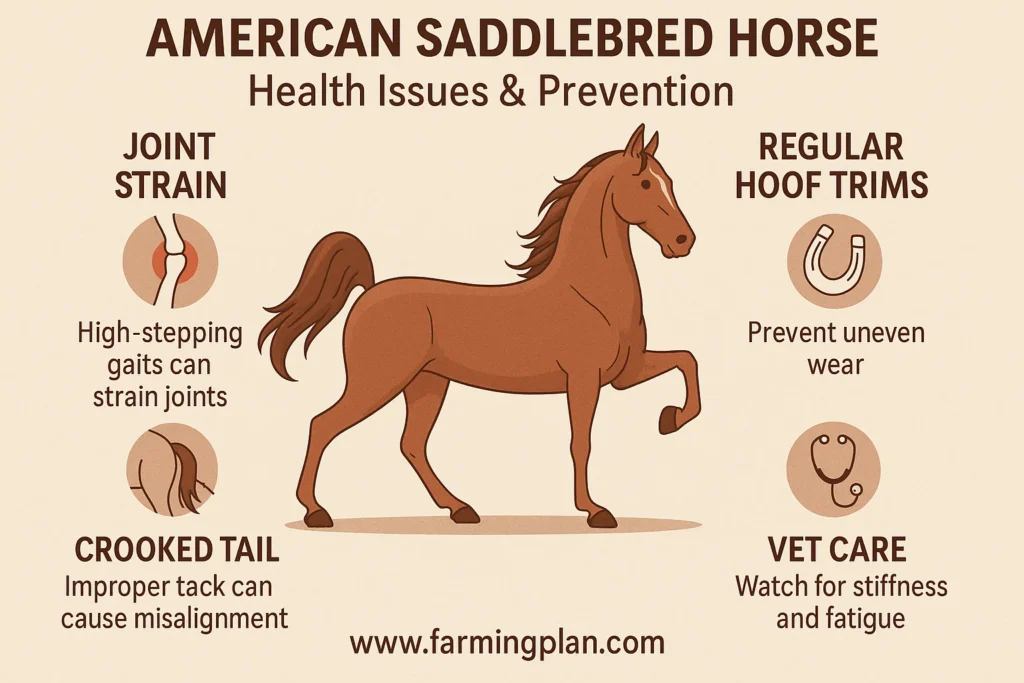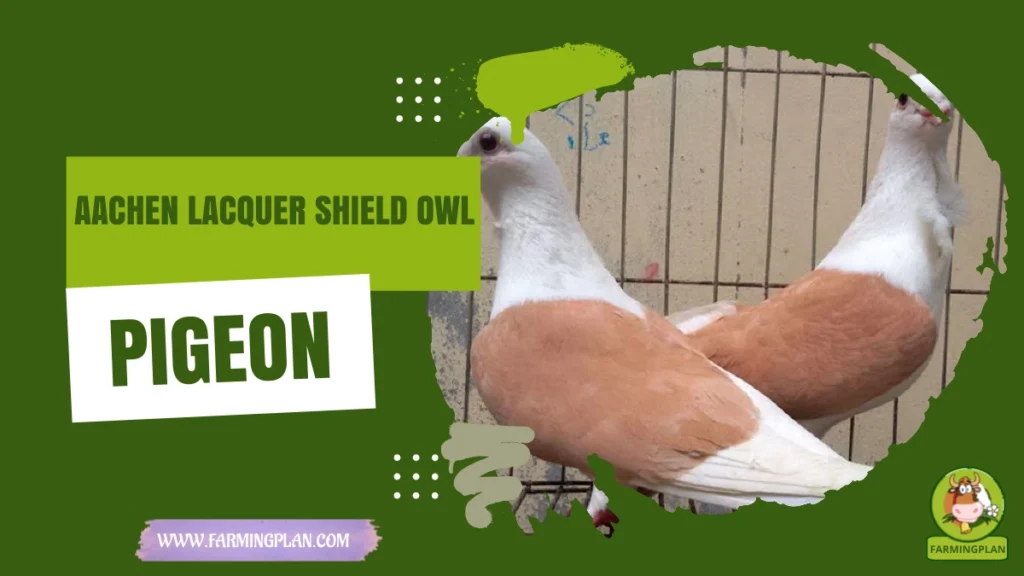I’ve been around horses most of my life, and let me tell you—there’s just something magical about the American Saddlebred Horse. With its proud posture, smooth four-beat gaits, and undeniable charm, this breed turns heads in every arena and melts hearts in every barn. Whether you’re into riding, showing, or just enjoying the beauty of a graceful American horse, the Saddlebred has something for everyone. Often called the “Peacock of the Horse World,” they’re more than just pretty faces—they’re forgiving partners, show-stopping performers, and all-around wonderful companions. In this article, I’ll walk you through everything I’ve learned about these incredible horses, from their rich history to hands-on care tips.

History & Origin of American Saddlebred Horse
The story of the American Saddlebred Horse goes back to the 19th century, starting right in the heart of Kentucky. Back then, folks needed a versatile horse—something they could ride all day and still look sharp in town. Enter the Narragansett Pacer and John Hunt Morgan’s influence, two foundational figures who helped shape what we now call the American Saddlebred Horse.

These horses were bred initially for comfort and stamina. They served as Confederate horses and reliable mounts during the Civil War, thanks to their endurance and grace. As time rolled on, they started shining in parades and shows. The formation of the American Saddlebred Horse Association played a massive role in documenting pedigrees and setting a clear breed standard. Today, they’re not just a nod to history—they’re stars in the ring, admired by breeders at horse shows and loved by riders of all ages.
Characteristics of American Saddlebred Horse
If you’ve ever seen an American Saddlebred Horse mare or stallion strut across a ring, you know they’ve got style. One of their most striking features is their high-stepping knee action. It’s elegant, dramatic, and unforgettable. They carry their heads high and tails even higher—literally. That high-carried tail is part of what makes them so recognizable.
They usually stand between 15 to 17 hands tall, and while their bodies are athletic, they’re never bulky. You’ll see various coat colours, from chestnut and bay to Palomino and Pinto. Some even have colour pinto patterns, like the first-known pinto Saddlebred, which adds a flashy flair. Their heads are often described as plain, but I’d call it classic—refined with a soft eye that shows just how intelligent and aware they are.
Read More: Plantation Horse: The Ultimate Ride for Comfort and Distance
Nature & Temperament of American Saddlebred Horse
I’ve worked with many breeds, but few are as people-oriented as the American Saddlebred Horse. These horses genuinely enjoy the interaction. They’re curious, quick learners, and have a personality that makes them excellent for beloved lesson horses, not just show animals.

Their temperament is gentle and patient—perfect for beginners, kids, or anyone wanting a forgiving partner. But don’t mistake their kindness for laziness. They’ve got energy and enthusiasm, especially in performance settings where their natural showmanship kicks in. Whether you’re into dressage, carriage horses, or casual riding, these horses adapt beautifully.
Food & Diet of American Saddlebred Horse
Feeding a Saddlebred isn’t rocket science, but it does take consistency and attention to detail. I ensure mine get a balanced diet of quality hay (like timothy or orchard grass), a bit of grain, and access to fresh water at all times. I’ll add some supplements for performance horses or those in training for joint and hoof support.
Avoid feeding large meals all at once—it can lead to bloating or worse. Instead, break it up into smaller portions throughout the day. Don’t forget salt blocks and mineral supplements; smooth gaits take strong bones and hydrated muscles. Horses with poor nutrition are more prone to deformities in horses, especially in growing colts and fillies. So feed with care, and always observe how they respond to what’s on their menu.
Usage & Purpose of American Saddlebred Horse
The American Saddlebred Horse shines in the five-gaited division, but they’re not all suitable. These horses are used in everything from ranch horse classes and endurance riding to elegant carriage driving. I’ve even seen them hold their own in combined driving events.
Their calm nature and stunning looks make them stars at traditional multi-breed horse shows, especially events like the Celebration of Horses and performances at Madison Square Garden. While they’re built for the show ring, they’re equally suited to trail riding, parades, and being the “perfect horse” in a family barn. I call that versatility at its finest.
Special Features of American Saddlebred Horse
Now, let’s talk about the wow factor. What sets this breed apart is its additional gaits—especially the slow gait and the rack, two flashy, four-beat ambling gaits that make them the ultimate five-gaited horse. These smooth gaits feel like floating when you’re in the saddle. The American Saddlebred Horse also has this incredible sense of presence. It’s hard to describe until you’ve seen it. They enter a ring and own the space—tail high, eyes bright, knees lifting like they’re dancing. Their inherent elegance and history of tremendous legacy make them a breed that’s as proud as they are powerful.
Every Saddlebred Deserves A Place To Shine—Give Them Care, Space, And A Bit Of Sass, And They’ll Dance Right Into Your Heart.
Health Issues & Prevention of American Saddlebred Horse
Like all breeds, the American Saddlebred Horse has a few health concerns to watch out for. Those stunning gaits can lead to joint strain, especially in horses trained young without proper care. Regular hoof trims are necessary, as uneven wear can cause gait abnormalities.

Some Saddlebreds may develop crooked tails or other alignment issues from improper equipment or posture, so always use properly fitted tack. I stick to regular vet checks, deworming, and vaccinations and pay close attention to any signs of stiffness or fatigue. If your Saddlebred’s energy drops or gait changes, it’s time to call the vet—sooner is always better.
Read More: Peruvian Paso Horse: Don’t Miss Out on the Smoothest, Most Powerful Ride of Your Life
Step-By-Step Care Guide For The American Saddlebred Horse
Taking care of an American Saddlebred Horse doesn’t have to be overwhelming. In this step-by-step guide, I’ll walk you through the essentials—from creating a safe environment to choosing tack, grooming, training, and daily health checks. Whether you’re new to horses or want to up your game, these five easy-to-follow steps will help prepare your Saddlebred healthy, happy, and show-ring.
Step 1: Set Up A Safe And Spacious Environment
First things first—your Saddlebred needs room to shine. These horses are naturally active and expressive so that cramped spaces won’t cut it. I recommend at least one to two acres of turnout space per horse. A well-fenced pasture with no-climb wire, wooden rails, or electric tape (the safe kind) is ideal. Watch for hazards like sharp edges, broken boards, or loose fencing—they’ll find them, trust me.
Footing matters, too. Avoid slick mud or rocky patches—rotate pasture areas to give the grass time to recover and reduce wear and tear. For shelter, a three-sided run-in shed provides wind protection and shade in summer. If you’re stalling your horse, go for well-ventilated barns with dry, fluffy bedding like straw or dust-free shavings. I make it a habit to walk my pastures every few days. I check for holes, weeds like buttercup or ragwort (which are toxic), and broken fencing. Daily turnout is a must—at least 4–6 hours. It keeps their joints loose and their minds happy. A bored American Saddlebred Horseis a recipe for chewing, pacing, and stress.
Step 2: Choose The Right Saddlebred Saddle And Tack
You wouldn’t run a marathon in bad shoes—and neither should your horse! Saddlebreds have a distinct build with high withers and animated front-end movement. That means off-the-rack saddles often don’t fit right. I always use a Saddlebred-specific saddle or a custom-fitted English saddle with a cutback head to accommodate their shape. Look for a lightweight, flexible tree that moves with the horse rather than pinching. A poorly fitting saddle causes soreness and ruins their natural gait. I also love using non-slip saddle pads for extra cushion and support, especially during longer rides.
As for the bridle, go for something elegant but functional—like a fine leather bridle that allows for loose but balanced rein contact. American Saddlebred Horse are all about the head carriage, so a well-fitted bit and properly adjusted browband and cheek straps matter more than you’d think. Before every ride, I do a full tack check: look for worn leather, rusty buckles, or loose stitching. A minor tack issue today can turn into a big behaviour issue tomorrow.
Step 3: Grooming And Hoof Care
Here’s the part I secretly love the most—grooming time. Not only does it keep your Saddlebred-looking show-ready, but it also builds a bond that’s hard to beat. I start with a rubber curry comb to lift dirt and loosen hair, then follow with a stiff brush to sweep it all away. Don’t forget the underbelly, behind the elbows, and under the jaw—those spots collect grime fast.Manes and tails deserve special attention. Use your fingers or a wide-tooth comb to detangle; never yank. I spritz mine with a detangler spray to avoid breakage. Pick the hooves out daily.
Saddlebreds often perform on firm or even paved surfaces, so thrush and bruising can be issues if you slack off. I like using a hoof conditioner twice or thrice a week—especially in dry or overly wet conditions. Fly spray is another must-have. These horses have sensitive skin, and too many bites can lead to sores or stress. Keep your brushes clean and stored dry to avoid mildew and bacteria. And if you spot anything odd—like bumps, swelling, or skin flakes—don’t ignore it. Minor signs can mean something big is coming.
Step 4: Training With Gaits In Mind
Training a American Saddlebred Horse is part dance lesson and part brain teaser. They’re intelligent and love having a job, but don’t expect them to go through the motions—they’ll need variety and praise. I begin with the groundwork basics: leading, lunging, yielding the hindquarters, and working with soft cues. It lays the foundation for everything under saddle. When you’re ready to ride, focus on the basics before diving into those showy gaits. A solid walk, trot, and canter routine is your base. Then, you can introduce the slow gait and rack, using voice cues and light rein contact.
Don’t push them too fast—these extra gaits take coordination, muscle memory, and time. Praise them for trying, even if it’s messy at first. I usually work in short, 20–30 minute sessions, especially with young or green horses. Keep them focused but not overwhelmed. Mix things up with poles, small hills, or trail obstacles. Variety keeps them sharp, and fun builds trust. Above all, listen to your horse. If they seem confused or resistant, go back a step. Progress isn’t linear, and that’s okay.
Step 5: Feed And Monitor Daily
Last but not least—feeding and daily care. Saddlebreds don’t usually need a high-calorie diet unless they’re in heavy training, but they need quality hay—at least 1.5% of their body weight daily. I prefer orchard or timothy grass hay for most of mine, paired with a pelleted feed that balances vitamins and minerals. Always provide clean, fresh water—especially during hot months when dehydration can quickly occur. I check water buckets twice daily and scrub them out weekly. I also offer free-choice salt blocks, and in winter, I mix warm water with beet pulp to keep them hydrated.
Monitoring your horse is a daily ritual. I glance over mine from head to hoof every morning. Are they bright-eyed? Eating normally? No weird swellings or cuts? A horse off their grain, standing oddly or seeming dull, needs attention. Better safe than sorry. And during extreme weather—snowstorms or heatwaves—I adjust rations, turnout time, and even riding schedules to protect their well-being.
Read More: Missouri Fox Trotter Horse: The Shocking Truth Behind Its Incredible Endurance and Smooth Ride
Expert Tips & Best Practices For Success
- Start slow with gait training—master walk, trot, and canter before moving on.
- Always fit tack properly to avoid discomfort and training setbacks.
- Avoid overworking young horses—protect their joints while they grow.
- Show often! It builds experience and bonds.
- Keep records, such as vet visits, diet changes, and training notes. They matter.
FAQ
What makes the American Saddlebred a five-gaited horse?
In addition to walking, trot, and canter, saddlebreds can perform slow gait and rack—shear, showy four-beat gaits.
Are Saddlebreds suitable for beginners?
Yes! They’re calm, patient, and easy to train. Many are used as lesson horses for kids and adults.
How tall do Saddlebreds usually grow?
Most stand between 15 and 17 hands, with a long, elegant frame.
What is the American Saddlebred Horse Association?
The official registry records pedigrees maintains the breed standard and supports breeders.
Can Saddlebreds be used for trail riding or shows?
They’re great for both! Their stamina and friendly nature make them as fun on trails as in the ring.
Conclusion
The American Saddlebred Horse is more than just a showstopper—it’s a loyal partner, a versatile performer, and a living piece of American history. Whether you’re into a high-stepping competition or peaceful trail rides, this breed offers grace, strength, and heart. Their unique personality, smooth gaits, and impressive presence make them unforgettable. I’ve worked with many horses, but the Saddlebred always finds its way back to the top of my list—and once you meet one, you’ll understand precisely why.


